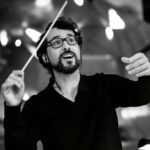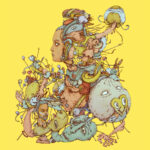 With her gorgeous, passionate style and firecracking energy, Cuban-born and raised conductor Cosette Justo Valdés has garnered acclaim on both sides of the Atlantic and is a rising star on the world’s concert stage. She is presently Resident Conductor of the Edmonton Symphony Orchestra (Canada) where she won the hearts of musicians and audience alike with her “unique style, full of flaming energy and human warmth.” Recent highlights include a “mindblowing” (Ottawa Citizen) collaboration with Esperanza Spalding and the National Arts Centre Orchestra in Ottawa, and a praised Così fan tutte with the Edmonton Opera, conducted from the harpsichord.
With her gorgeous, passionate style and firecracking energy, Cuban-born and raised conductor Cosette Justo Valdés has garnered acclaim on both sides of the Atlantic and is a rising star on the world’s concert stage. She is presently Resident Conductor of the Edmonton Symphony Orchestra (Canada) where she won the hearts of musicians and audience alike with her “unique style, full of flaming energy and human warmth.” Recent highlights include a “mindblowing” (Ottawa Citizen) collaboration with Esperanza Spalding and the National Arts Centre Orchestra in Ottawa, and a praised Così fan tutte with the Edmonton Opera, conducted from the harpsichord.
Cosette maintains strong ties to her native Cuba, where she is celebrated as Honorary Director of the prestigious Orquesta Sinfónica de Oriente in Santiago, Cuba’s musical heartland, which she led for 9 years. During that time, she single-handedly (with a team formed by an administrator and a librarian) managed and directed the 80-musician ensemble, developing an extensive repertoire of classical and contemporary music, jazz and pop, while championing Cuban music both new and traditional. A frequent guest conductor of the National Symphony Orchestra of Cuba in La Habana, she premiered works by Cuba’s musical luminaries including Leo Brouwer, Alfredo Diez Nieto, Roberto Valera, and many more.
With the Edmonton Symphony Orchestra, Cosette is equally at ease leading programs from the Masters, Pops, or Kids series, garnering praise from critics, audience, and musicians alike for her “incisive presence,” “vivacity,” and “inspiring, precise, fiery” conducting. Her position with the orchestra since 2019 includes the role of Community Ambassador, through which she has developed an exceptionally warm and rewarding relationship with orchestra patrons as well as the city’s arts community. Cosette is also the Artistic Director of the Youth Orchestra of Northern Alberta, the ESO’s Sistema-based program that provides free music education to some 200 children from Edmonton’s priority neighborhoods and surrounding First Nations.
Cosette holds her bachelor degree in conducting with Prof. Jorge López Marín at the Instituto Superior de Arte (La Habana, Cuba) and her master degree with Prof. Klaus Arp at the Staatliche Hochschule für Musik und Darstellende Kunst (Mannheim, Germany). As part of her training, she has assisted many conductors in Europe and the Americas, including Klaus Arp (Germany), Francesco Belli (Italy), Alexander Prior (UK), Alexander Shelley (UK) and Mario Venzago (Switzerland).
She has guest-conducted with dozens of orchestras in Germany and Eastern Europe, such as the Stuttgart Philharmonic Orchestra, Theater und Orchester Heidelberg, and Nationaltheater Mannheim. In addition to her duties with the Edmonton Symphony, Cosette has upcoming engagements from coast to coast in Canada, as well as across the Americas. Some highlights include two concerts with Saskatoon Symphony Orchestra, 5 concerts with Thunder Bay, a collaboration with the Against the Grain Experimental Opera in Toronto and a repeat invitation with NACO in Canada, Orquesta Sinfónica de la Universidad de Guanajato (Mexico).
 Casey Peden holds a Master of Music in Vocal Performance and a Bachelor of Music in Vocal Performance from the University of Alberta. Her professional development continued through Tafelmusik’s Baroque Summer Institute, the Early Music Vancouver Vocal Summer School and private lessons. Ms. Pedens’ teachers include Linda Perillo, Harold Wiens, Ellen Hargis, and Lisa Hornung.
Casey Peden holds a Master of Music in Vocal Performance and a Bachelor of Music in Vocal Performance from the University of Alberta. Her professional development continued through Tafelmusik’s Baroque Summer Institute, the Early Music Vancouver Vocal Summer School and private lessons. Ms. Pedens’ teachers include Linda Perillo, Harold Wiens, Ellen Hargis, and Lisa Hornung.

 It began with a childhood dream growing up in Nova Scotia. At the age of 18 months, Kevin’s first teacher was his mom.
It began with a childhood dream growing up in Nova Scotia. At the age of 18 months, Kevin’s first teacher was his mom. Armand Birk
Armand Birk